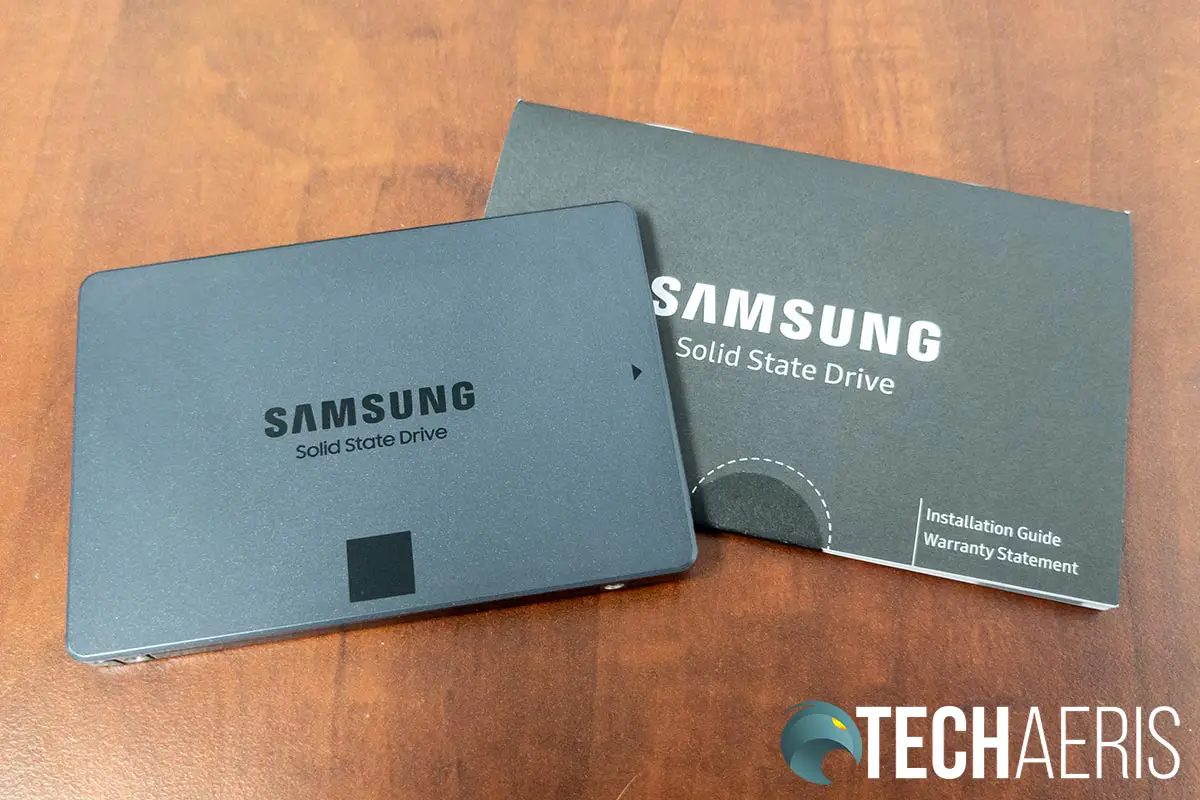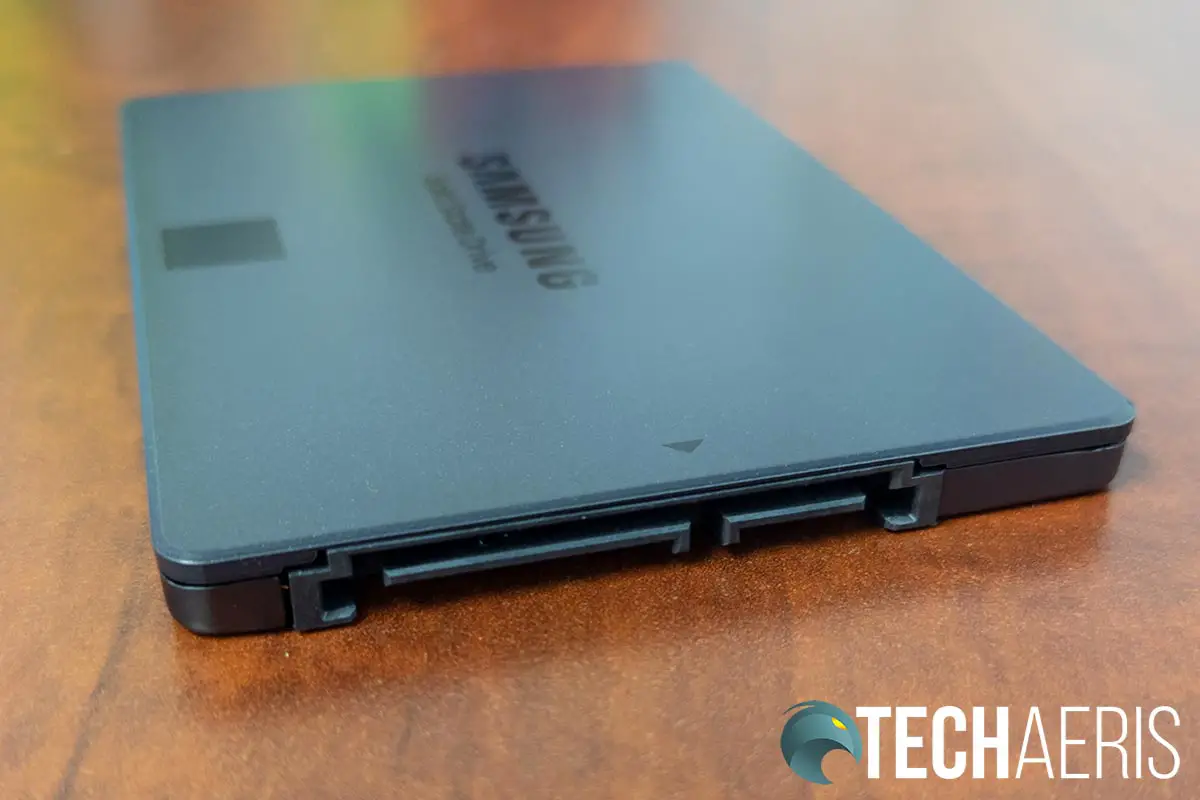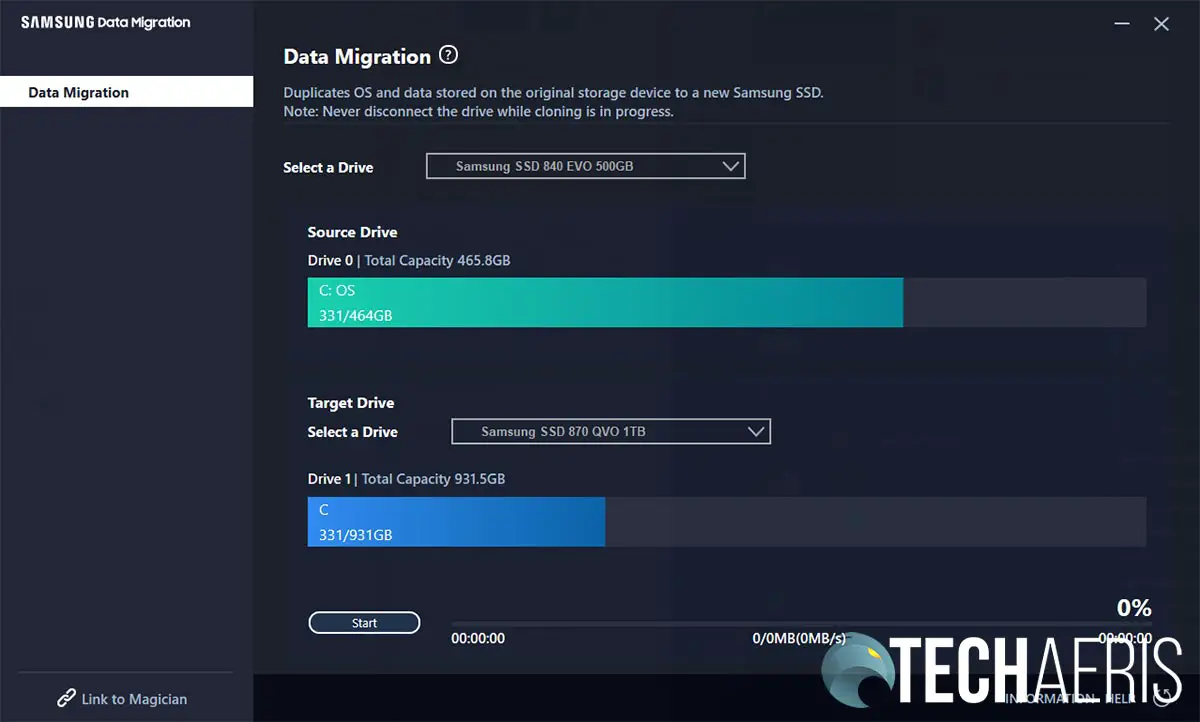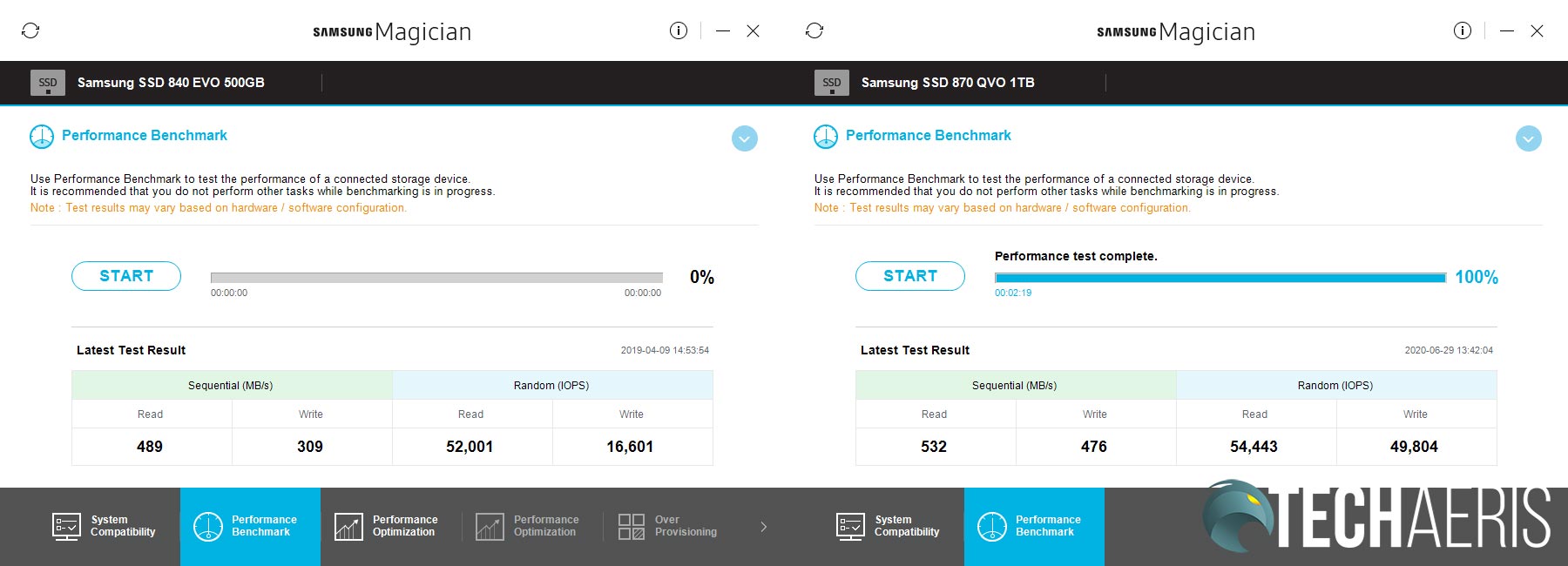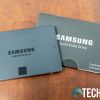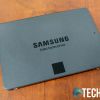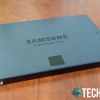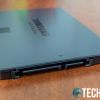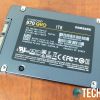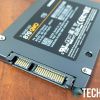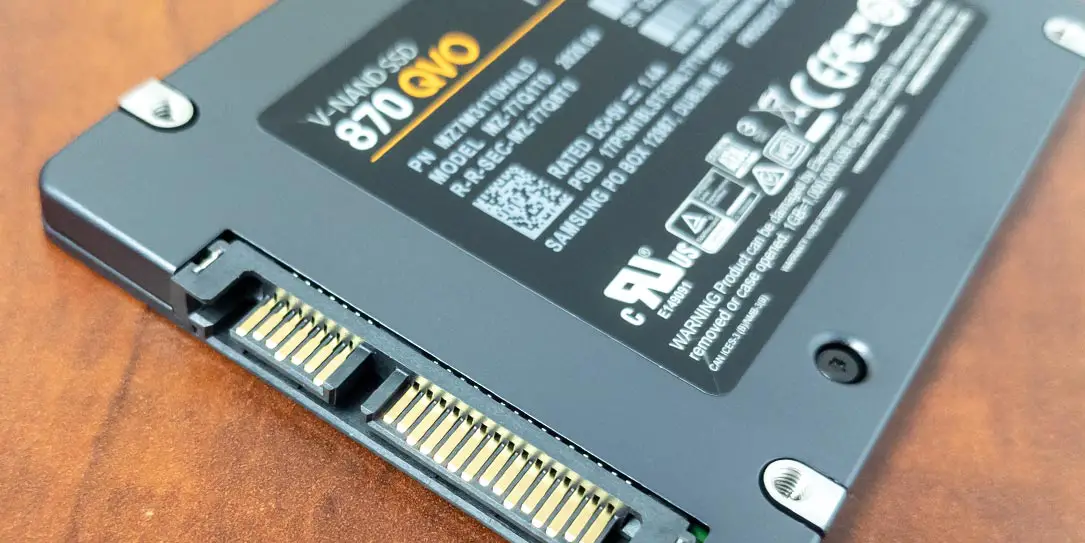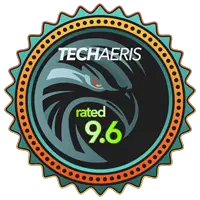
There is no question that a faster hard drive can make your computing experience more enjoyable. Over the years, hard drive technology keeps improving, bringing faster, cheaper, and larger storage options. Solid state drives (SSDs) are much faster than hard disk drives (HDDs) and have been the industry standard for years. While NVMe SSDs are fairly popular in newer computers, 2.5-inch SATA SSDs are still sought after in older systems for upgrades and newer ones for extra storage.
Samsung is one OEM that manufactures hard drives — NVMe and SATA SSDs included. Today, they’ve announced an update to their consumer QVO SATA SSD lineup — the Samsung 870 QVO V-NAND SSD. With read speeds of up to 560MB/s and write speeds of up to 530MB/s, the 870 QVO SATA SSD comes in 1, 2, 4, and 8TB options. Combined, this offers enhanced reliability and performance, as well as double the storage as the previous 860 QVO.
“Following the launch of Samsung’s first consumer QLC drive – the 860 QVO – in 2018, we are releasing our second-generation QVO SSD which offers doubled capacity of 8TB as well as enhanced performance and reliability. The new 870 QVO will allow more consumers to enjoy the performance benefits of an SSD at HDD-like capacities.”
Dr. Mike Mang, vice president of the Memory Brand Product Biz Team at Samsung Electronics
According to Samsung, the 870 QVO delivers a 13% increase in random read speed over the 860 QVO. In addition, the drive also uses Intelligent TurboWrite technology and a large variable SLC buffer. This technology adjusts the buffer size on the drive based on usable disk space. Depending on the size, the drive also offers up to 2,880 terabytes written (TBW) or a three-year limited warranty.
The Samsung 870 QVO V-NAND SSD is available starting today, with a starting suggested retail price of US$129.99/CA$179.99. Samsung Canada was kind enough to send us one over for an early review. As such, our Samsung 870 QVO V-NAND SSD review takes a look at the 1TB version of the company’s new SATA SSD. Read on to see how it performs!
Specifications
The Samsung 870 QVO V-NAND SSD has the following features and specifications:
| Model | MZ-77Q1T0 |
| Interface | SATA 6 Gbps |
| Form Factor | 2.5-inch |
| Storage Memory | Samsung V-NAND 4-bit MLC (QLC) |
| Controller | Samsung MKX Controller |
| DRAM | 8GB LPDDR4 (8TB) 4GB LPDDR4 (4TB) 2GB LPDDR4 (2TB) 1GB LPDDR4 (1TB) |
| Capacity | 8TB, 4TB, 2TB, 1TB |
| Sequential Read/Write Speed | Up to 560/530 MB/s |
| Random Read/Write Speed | Up to 98K/88K IOPS |
| Management Software | Samsung Magician |
| Total Bytes Written | 2,880TB (8TB) 1,440TB (4TB) 720TB (2TB) 360TB (1TB) |
| Warranty | Three-year limited warranty |
What’s in the box
- Samsung 870 QVO V-NAND SSD
- Installation Guide & Warranty Statement
Design
To be honest, there’s not much to say here. Due to installation constraints, SATA SSDs are pretty similar. The Samsung 870 QVO is 4 inches long, 2 3/4 inches wide, and about 1/4 inch thick. There are two screw holes on each long side, as well as four on the bottom, for mounting in an SSD tray on your laptop or desktop computer.
The entire hard drive is enclosed in a dark gray casing with the SAMSUNG logo and words Solid State Drive printed on the front in black. The bottom contains a label with size, model, serial number, and other regulatory information. Finally, one of the short edges has your SATA connector.
As mentioned, it’s a standard design and fits as one would expect within a computer.
Installation
Installation will vary depending on your laptop or desktop computer. The Samsung 870 QVO SSD can also be used in an external SATA enclosure but you may get slower speeds. At any rate, we installed our review unit inside a laptop, upgrading from a Samsung 840 EVO SSD.
NOTE: you’ll want to read the next section first if you’re replacing your primary drive with the 870 QVO. If not, you can proceed with the installation in a spare SATA slot or external enclosure.
In my case, the laptop required removing two screws and a panel on the bottom to access the hard drive bay. Once opened, I removed four more screws to remove the existing 840 EVO SSD. I then removed the four screws holding the SSD in the tray. Once removed, I placed the 870 QVO in the tray caddy and screwed it into place. Once screwed back into the laptop, I replaced the bottom panel and secured it. Easy enough.
If you’re just adding the drive to your computer or an external enclosure, the entire process should take less than five minutes. If you are cloning the drive, the upgrade process will take longer but shouldn’t take much more than an hour. Of course, as mentioned below, this depends on the amount of data you are cloning.
Software
There are two software apps you’ll likely use with the Samsung 870 QVO V-NAND SSD. If you’re upgrading your hard drive in your computer, you’ll want to start off with the Samsung Data Migration application. Once you’ve used that, or if you’re not migrating, you can then install and use the Samsung Magician application for further monitoring. Both can be downloaded from the Samsung website.
Samsung Data Migration
The Samsung Data Migration tool is available from Samsung’s website and is super simple to use. Start by downloading and installing the app. Next, place the 870 QVO into an SSD enclosure and connect it to the computer you’re upgrading. It is important to connect the external drive first so the application can see it.
Once that’s done, launch the Data Migration application. The interface is simple. You’ll see a source drive option and a target drive option. Select your source drive, if you have more than one, then select the Samsung SSD 870 QVO as the target drive. Finally, press the start button and sit back and wait for the cloning to finish. I did get a notice saying the computer would restart in 20 seconds once complete, as well as prompting me to close any open files as they wouldn’t be cloned.
Your cloning time will vary based on the amount of data you’re moving over. In my case I was cloning a 500GB Samsung SSD 840 EVO with 331GB of data on it and it took about an hour. Once cloning finished, the computer did shut down. For peace of mind, you might want to boot it back up and verify the contents on the cloned drive just to make sure everything good before physically installing it in your computer.
NOTE: The Data Migration tool works with any brand drive as the source as long as the target drive is a Samsung drive.
Samsung Magician
With Samsung Magician, which received a recent facelift in version 6, you can view the health of your Samsung SSD drive, the amount of data written, diagnostic scan, over provision, optimize performance, secure erase, PSID revert, and encrypt the drive. Drive details, diagnostic scan, performance optimization, secure erase, and drive encryption are pretty self-explanatory features. Over provisioning allows you to allocate a recommended or specific capacity to help improve the performance and life of the SSD. PSID revert allows you to unencrypt encrypted storage (but will delete the data on your drive).
The new look of Samsung Magician 6 seems more fluid than that of version 5. It is straightforward and easy to navigate with helpful hints for each feature of the application.
Performance
Samsung has three lines of SATA SSDs: the QVO, EVO, and PRO. As mentioned above, our test machine was running the 840 EVO 500GB, which while an older drive is the mid-tier performance level. Our test machine for SATA SSD is a bit older and runs an Intel Core i7-6700HQ CPU with 16GB of RAM. Before I continue, I just want to mention that our performance score is based on SATA III performance, not compared to what you might get out of an NVMe SSD. Just a reminder, when running performance benchmark tests, you will get varying numbers. The numbers below are listed based on a first run test while we ran two more tests after which, generally speaking, were in line with the first run.
For the 840 EVO, Samsung Magician reported a sequential read/write speed of 521MB/s and 469MB/s respectively. On the random IOPS test, the 840 EVO achieved 55,175 read and 15,380 write.
The 870 QVO has a maximum read/write of up to 560/530 MB/s and up to 98K/88K IOPS. During testing, we achieved read/write speeds of 533MB/s and 471MB/s. On the random IOPS test, the drive reported 54,443 read and 49,804 write. CrystalDiskMark returned similar results of 530.02MB/s and 469.87MB/s sequential read/write. As always, AS SSD returned slightly slower results of 498.23MB/s and 428.62MB/s sequential read/write.
What’s better is that Samsung SATA SSDs come with a RAPID mode option which can be enabled in the Performance Optimization section of the Samsung Magician application. In a nutshell, RAPID mode uses part of your computer’s memory as a read/write cache for the SSD. When enabled, I was able to achieve just over 3000MB/s sequential read and just under 3000MB/s sequential write. This translates into a roughly 500% increase in read/write speed for the SSD and your computer will definitely feel snappier as a result.
Given the theoretically maximum of the SATA III controller is 600MB/s, the Samsung 870 QVO performed quite well. While on par for read/write with the EVO, it did perform much better with the random IOPS write speed. It’s always hard to say with these things, but the 870 QVO does seem a bit snappier (but not by much) than the 840 EVO. Of course, the real matchup would be between this drive and a newer version of the EVO due to advances in SSD technology over the past few years.
At any rate, apps like Photoshop and Lightroom ran fine and as expected, as did the couple games I tested which included Forza Horizon 4 and Heroes of the Storm. Launching Forza Horizon 4 only took a minute, shaving off 5 seconds from its 840 EVO counterpart. Booting Windows 10 from a powered off state was slightly quicker than the 840 EVO, taking about 17 seconds instead of 22.
Regardless, if you’re looking for a reasonably priced SATA SSD drive for an upgrade or extra storage, the 870 QVO performs decently enough. Check the chart below for comparisons with other drives we’ve reviewed. NOTE: the WD Black SN750 is an NVMe and is just shown as a comparison between SATA and NVMe speeds.
| Samsung 870 QVO SSD | Samsung 870 QVO SSD (with RAPID enabled) | Samsung 840 EVO SSD | SK hynix Gold S31 SSD | WD Black SN750 | |
| Samsung Magician Seq Read | 533MB/s | 3023MB/s | 521MB/s | 534 MB/s | 3,219 MB/s |
| Samsung Magician Seq Write | 469MB/s | 2913MB/s | 469MB/s | 469 MB/s | 2,952 MB/s |
| Samsung Magician IOPS Read | 54,443 | 88,134 | 52,001 | 60,302 | 118,896 |
| Samsung Magician IOPS Write | 49,804 | 38,330 | 16,601 | 17,578 | 104, 980 |
| CrystalDiskMark Seq Read | 530.02MB/s | 526.63MB/s | 539.09MB/s | 3367.5 MB/s | |
| CrystalDiskMark Seq Write | 469.87MB/s | 466.85MB/s | 441.50MB/s | 2960.9 MB/s | |
| AS SSD Seq Read | 498.23MB/s | 479.69MB/s | 490.66MB/s | 2876.66 MB/s | |
| AS SSD Seq Write | 428.62MB/s | 421.91MB/s | 408.07MB/s | 2,044.22 MB/s |
Price/Value
With an MSRP of US$129.99/CA$179.99, the Samsung 870 QVO V-NAND SSD is roughly in line with other 1TB SATA SSDs on the market. It is priced a bit more above most as many products are on sale due to being on the market for some time. Based on that and the performance, you’re getting a pretty decent value for the price which includes a 3-year warranty.
If you want the larger capacities, you’ll be looking at US$249.99 for the 2TB and US$499.99 for the 4TB. The 870 QVO 8TB will be available in August for US$899.99. You can purchase the drives on the Samsung (Canada) or Amazon (Canada) websites once they are listed.
Wrap-up
As mentioned above, if you’re looking for a reasonably priced SATA SSD drive for an upgrade or extra storage, the Samsung 870 QVO V-NAND SSD performs decently enough. Not only that, it is available in capacities of up to 8TB.
In some of our articles and especially in our reviews, you will find Amazon or other affiliate links. As Amazon Associates, we earn from qualifying purchases. Any other purchases you make through these links often result in a small amount being earned for the site and/or our writers. Techaeris often covers brand press releases. Doing this does not constitute an endorsement of any product or service by Techaeris. We provide the press release information for our audience to be informed and make their own decision on a purchase or not. Only our reviews are an endorsement or lack thereof. For more information, you can read our full disclaimer.
Last Updated on February 3, 2021.

